My summer romance with Alpha Constructed League has affirmed and deepened a conviction which I’ve long held, albeit tenuously: that Magic is the greatest game ever created. Granted, I haven’t played every game ever made, so this is a conviction of faith more than fact. It is one based, nonetheless, on an appreciation of the incredible potential, strategic depth, and immense fun bound up in the game design.
Playing Alpha Constructed has been a clarifying experience. It has given me a fresh perspective on a game I’ve enjoyed for nearly three decades. This format is like a solvent that sheds all of the ornaments and garnish that have been attached to the game over the years. No Pro Tours, Grand Prix, Pre-releases, Releases, Expansions, specialty sets, or novel mechanics. It is pure: Alpha Constructed is the game stripped down to its essence: 5 colors, artifacts, and land.
In Alpha Constructed, every card matters, and nothing – not even Wards! – are beyond the pale. Cards that are innocuous in any other context are serious business here. Psychic Venom is perfectly named in Alpha Constructed. And the so-called “Charms” (Iron Star, Ivory Cup, Wooden Sphere, Thorn of Bone, Crystal Rod, and Soul Net) are more than mere annoyances. They are game-extending menaces that grow more troublesome over time.
As the June league unfolded (where I played a Blue-Black Aggro-Control deck), I gradually became aware of a desire to play something extremely different in July, rather than run back a slightly tuned version of the same concept, and try to improve upon my performance. Part of the fun of playing Alpha Constructed is certainly the aesthetics and the beautiful cards, but I also wanted to explore more vantage points within the parameters of the league rules.
Building my July Alpha League Deck
I considered my growing card pool, and concluded that the combination of colors and cards that seemed the most fun, and gave me a good chance to compete, were Red and Green. After all, this was the color combination I had originally invested in building for the Wizards Tournament 2, so it was a slice of the color pie I was familiar and comfortable with.
With a critical mass of games under my belt, I recognized that there were precious few ways to accelerate in Alpha League. Sol Ring and Moxen were super-restricted. Although Mana Vault was trapped in the “Fast Mana Group.” Dark Ritual was available in unlimited quantities, but only good for Black. Birds of Paradise was an option, but outrageously expensive and moderated to three. I owned a half dozen Wild Growths, but those were going to be extremely risky in a format where players had been running so much land destruction. Llanowar Elves were an obvious outlier.
Llanowar Elves was one of the very few ways in the format to accelerate spells out more quickly. In particular, it could be used to cast a three mana spell like Ice Storm on Turn 2, or a four mana spell like a Juggernaut on Turn 3. That was extremely attractive.
Like Dark Ritual, you could play as many Llanowar Elves as you could acquire and reasonably include in an actual constructed deck. Although Llanowar Elves couldn’t get you the color flexibility, in League play, where it was exceedingly rare to run three or more colors, Llanowar Elves more than compensated by being a small offensive threat. Just as with limited draft formats, the cumulative threat of attacking for a few points of damage here or there matters.
And since Alpha League rules mandated a 40-card minimum library size, you could easily include enough Elves to consistently draw and cast one on the first turn. There is, of course, a point of diminishing returns, even with Elves. But I wanted to hit the sweet spot where I would reliably get an Elf, but rarely draw more than two. I viewed them as a disposable acceleration that, once no longer of service in generating quick mana, could be used on offense, or for late game Fireballs.
A rule of thumb emerged from League play that you roughly want 15 lands and your “fast mana” spell (the vast majority of the time will optimally be Sol Ring). Some players prefer slightly more, and others with low curves or mono-colored lists) can get away with less. But most Alpha League decks run 15. A further rule of thumb is that, for two color decks, you roughly split your basic land evenly, and include the appropriate dual land as the 15th land. For players who are not fortunate enough to own Alpha duals, you generally include an 8th basic of the primary color.
What this means is that for a 40-card deck, you are starting with about 16 mana, and then can fill out your deck from there. Knowing that I’d be playing a good number of Elves, naturally I included the maximum allowed number of Juggernauts (3). With Elves, I assumed I’d have plenty of surplus mana, which made Jade Statue a good deal as well, but I had to settle on a final number.
Channel is one of the most powerful cards you can run in this color combination, so I knew I’d include that. But I’d have to decide how many Fireballs or Disintegrates to include. I was permitted to play 3 Lightning Bolts, but only owned 2, so I’d be playing both of those. Hurricane is “moderated” in League rules because it is so powerful, but I only owned 1. I needed to decide whether to run it, even though I could use it as a finisher with Channel. Like Lightning Bolt, Hurricane was a fast answer to Hypnotic Specter, and potentially card advantageous as well (imagine dealing with a bunch of Mesa Pegasi!).
So, I knew that my core of deck would roughly look like this:
15 Land
1 Artifact Accelerant (either Black Lotus or Sol Ring)
X Llanowar Elves
3 Juggernaut
X Jade Statue
2 Lightning Bolt
X Fireball
0-X Hurricane
X Channel
And in each case, X was ‘To Be Determined.’ In addition, there were another half dozen cards I was considering: Ice Storm, Disrupting Scepter, Icy Manipulator, and other threats like Roc of Kher Ridges. The first decision I made was that I’d run all of the Fireballs I owned (5). In theory, this would give me a Fireball with relatively consistency early on, and Fireball would often be a 2-for-1 in the early/mid-game, and a win condition in the late-game.
In June, I bought 6 Llanowar Elves, and after goldfishing this for a bit, that felt like about the right number. I could see adding one more, but I never felt desperate for Elves at any point. Although I occasionally drew two in my opening hand, which created a little bit of early-game awkwardness, I didn’t mind them. The only time Elves were an irritant was if I drew three or four. Six total Elves seemed like a sweet spot where I could reliably get one in the early game, but wasn’t flooded with Elves as games progressed.
With reliable Elves, I discovered I wanted more Turn 2 and Turn 3 plays. This led me to Icy Manipulator (moderated in League play) and Disrupting Scepter (restricted in League play). Ice Storm seemed underwhelming, at least in relation to the opportunity cost. If I had a more dedicated land destruction plan, with Stone Rains, it would have been more compelling.
Similarly, with Jade Statue, you often wanted one, but you didn’t want to be flooded with Statues. Operating multiple Statues is a mana-intensive proposition. Three seemed like a good fit.
I owned a Disintegrate, but most of my damage was either artifact-based or red. It seemed like Hurricane was a good hedge in case I didn’t draw a Mountain but needed a second turn answer to Hypnotic Specter, and also gave me a direct damage means around Circle of Protection: Red, which is sometimes run main deck in Alpha Leagues, due to the combination with Orcish Artillery.
That led me to this list:
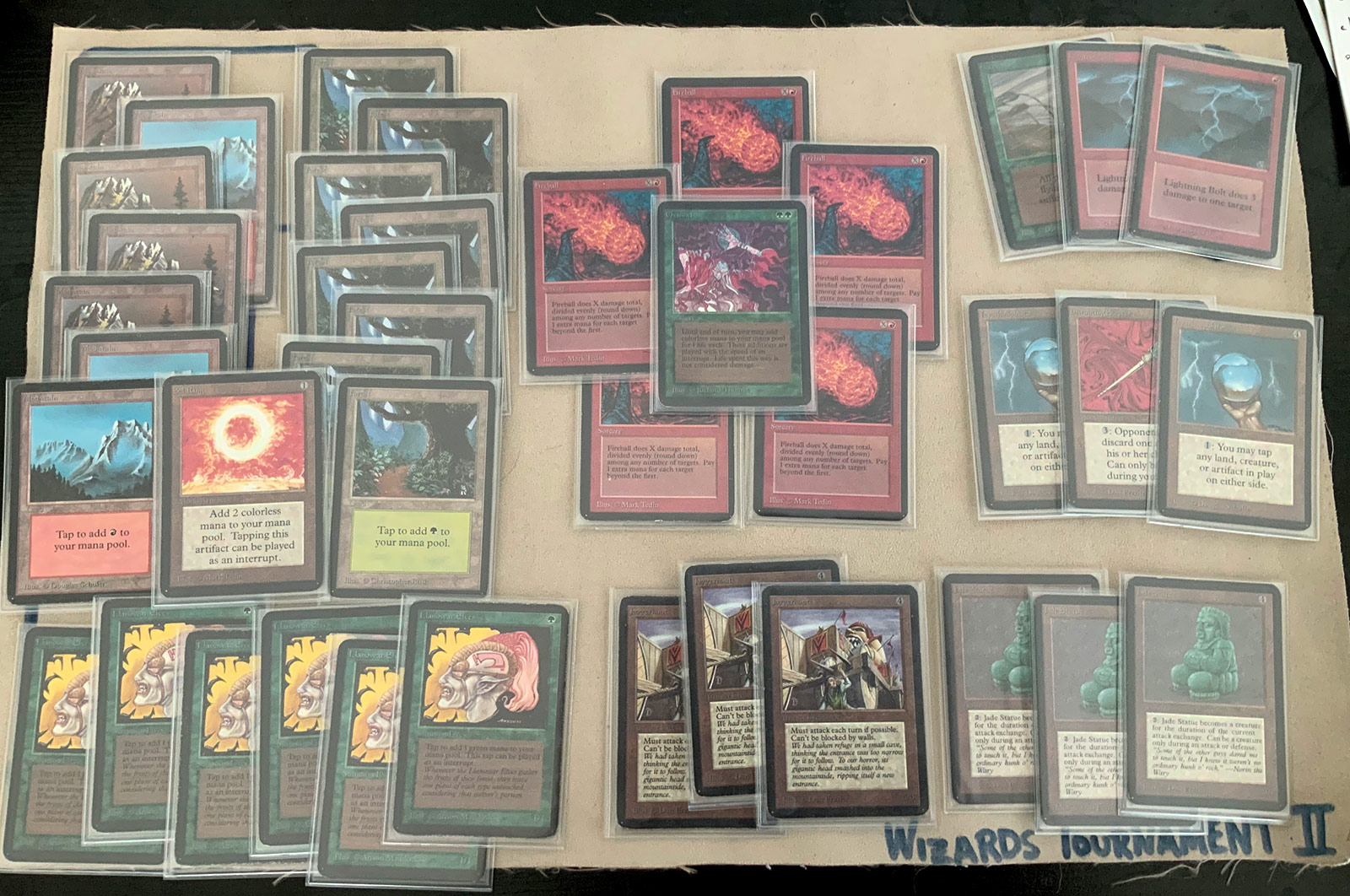
In June, all of the players were put into 8 pods of 8 players. This time, however, we were stuffed into pods of just 5 players, but more overall pods. This would be a more intimate experience.
Match 1 vs. Sebastian Dube playing Blue/White Control
I got a late start because I had to wrap up my June League with a playoff match. By the time I got to my first match, Sebastian had already notched a few July League match wins, so I figured this would be a real test.
Game 1: My opening hand is slow and plodding, with double Mountain and a Llanowar Elf, but no Forests. I win the die roll, and lead with a Mountain. He opens with a Plains.
On my second turn, I find the Forest, and cast the Elf. Sebastian quickly Swords to Plowshares it. On turn 4, I cast a Juggernaut, which he Disenchants.
On turn 5, I cast Disrupting Scepter, and he seems quite dejected. On his turn, however, he apparently topdecks a Disenchant, because he says as much, and immediately destroys my Scepter, which I was hoping would take over the game. Drat!
I slip an Icy Manipulator onto the table, and use it to keep him off of his limited blue mana. His mana is roughly 4 Plains and 2 Islands by turn 6, so the Icy prevents him from casting Counterspell, in theory.
I slip a Jade Statue onto the table, and get one attack before it, too, is sent farming.
The critical moment arrives, however, when he decide to cast a massive Braingeyser on himself, for roughly a half dozen cards. He taps out entirely to do this, but fills his hand to capacity.
This proves to be his undoing. He is tapped down, and I’m holding Channel and Fireball, with ample mana available, and plenty of additional life (24). I killed him in a single shot.
I had been holding Channel since Turn 3, but waiting to draw out his countermagic. Initially, I had hoped that the Scepter would do this, but then realized I’d have to grind him down.
Game 2: He opens with an Island and then a Tundra and a Sol Ring.
I play an Elf, which pecks at him until I cast Juggernaut, which he quickly removes with Swords to Plowshares. I play a second Elf and a Jade Statue, and then peck him down to 19, then 18, and then a pair of Elves down to 16. A Jade Statue joins the attack, dropping him down to 11.
But then he casts a Serra Angel, and does so with two Islands untapped. I have three Fireballs in hand, so I throw one of them at it, and it is predictably countered. Not the end of the world. I have more where that came from. It does prevent me, however, from continuing to attack. This single Serra holds back the Statues and the Elves.
I draw Disrupting Scepter, and a new plan forms. I tap Sol Ring and a Mountain and cast it, and then tap my remaining lands (sans my Elves) and activate it, forcing him to discard a land, leaving just two cards in his hand.
I draw Channel, and contemplate my options. I’m at 16 life and he’s at 17 or so. I have more than enough life and mana to kill him, but not if he has another counterspell. I contemplate using the Disrupting Scepter, taking him to 1 card. The problem is that he can just keep holding cards until the Angel kills me. I need to draw out spells as well. So I decide to throw a second Fireball at the Angel. If it resolves, I can attack for 5 (a Jade Statue and two Elves). Remember, he’s at just 11 life.
Unfortunately, he has a Power Sink for my Fireball. He’s now down to a single card, but draws another in his turn. Then he attacks me to 12 with the Angel. On my turn, I use the Scepter this time, taking him to one card, but he has another Counterspell for my second Fireball. He attacks me back down to 8. This time, however, he casts a Control Magic on one of my Elves.
This is the opening I needed. I activate Scepter to clear his hand, and then Fireball the Angel. Crisis averted. I have just enough mana to swing back with Statue, sending him to 8. I have him cornered. He draws and passes back.
I Scepter his last card in hand again, and he responds by Plowing my last Elf. I float a green mana, and cast Channel, plug two mana to Jade Statue, which sends him from 8 to 5 (and me to 5 as well), and then tap two Mountains to cast Fireball for 5, sending me to 1, but killing him. I also have a Bolt in hand, but didn’t need it. This was a more dramatic finish. Game over.
Here is what Sebastian played:
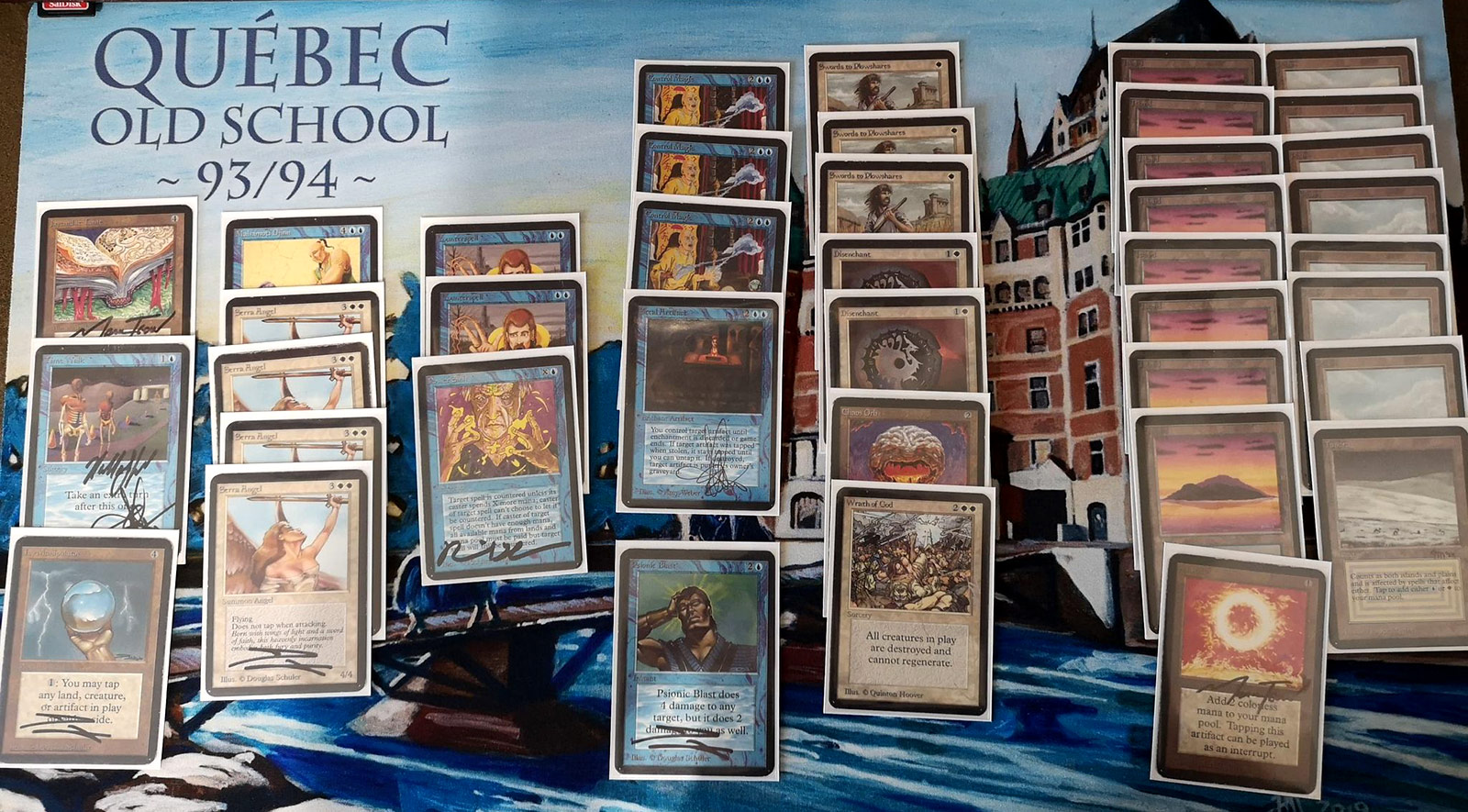
Sebastian informed me that the differences between this photo and what he played are:
– 1 Time Walk, -1 Jayemdae Tome, +1 Ancestral Recall, +1 Braingeyser
Match 2 vs. Nicholas Aiello playing Mono Red
My next match was against a player who was already 2-0 in our pod as well. This would, I figured, be the key matchup that determined whether I made it out of the July pod. Based upon the first match, I felt confident. It was a small sample, but I already felt like my deck in July was even better than my June deck.
Game 1: I lost the die roll, but my hand had Sol Ring, so all was well.
Nicholas opened with a Mountain. I played a Forest and cast Sol Ring and passed. On his second turn, he played another Mountain, but no Shatter. All clear!
On my turn, I played another Forest, cast Jade Statue and then passed the turn again. On his third turn, he missed his land drop, and discarded a Fire Elemental. Uh oh!
On my third turn, I played a Mountain, animated the Statue, and attacked for 3, sending him to 17. I then cast a Llanowar Elf, and passed the turn. I had a Lightning Bolt, two Fireballs, and another Statue in hand.
On his fourth turn, he couldn’t find another land, and discarded another spell. On my fourth turn, I cast the second Jade Statue, but attacked with just the Elves, sending him to 16. I figured this was the fastest route to ending the game.
Finally, on his fifth turn, he found a third land, and cast an Uthden Troll, which I Lightning Bolted. Then I attacked with two Statues and an Elf, sending him to 9.
He found another Mountain, and cast Dragon Whelp. Too late. I Bolted it as well, and then attacked him for 7, down to 2. He drew and then scooped.
Game 2: My opening hand was titillating. I had Channel, a pair of Fireballs, and plenty of mana to get it going. Could I win this way? My mind began puzzling out how I could get that extra point of damage to him.
He opened with a Mountain, and cast Iron Star! I opened with Forest, and Llanowar Elves. He Bolted my Elf, and gained a life. Rude!
I played a second Forest, and passed. He played another Mountain, Sol Ring, and cast Juggernaut.
Now I had to think about what to do. I had Channel, Juggernaut, and a pair of Fireballs, but only two Forests in play, and a land drop to make. I had several options, but here’s what I landed on. Play Mountain. Cast Channel. First, I paid 4 life to cast Juggernaut. Then, I gave up 7 more life, going to 9. I used this mana to cast a 3 point Fireball split between his Juggernaut and his life (sending him to 18).
This did not achieve the desired effect. He burned out my Juggernaut, and gained a few more life, going to 20, then 21, then 23 before I began applying pressure again. Then he landed a Jayemdae Tome, but, fortunately for me, bricked for a number of turns, drawing just Mountains.
I used Fireballs to keep his creatures from attacking me, I burned out a Dragon Whelp, but eventually I landed another Juggernaut, and then supplemented it with an Elf. This took his life from 23 to 18, then to 13, then to 8, and finally to 3. I couldn’t even Fireball him to finish him, because as long as he was untapped, he’d gain more life than lose when I cast Fireball. This time, however, he couldn’t find an answer to my Juggernaut and Elves, and the game and match was over.
Here’s the sweet brew he played:
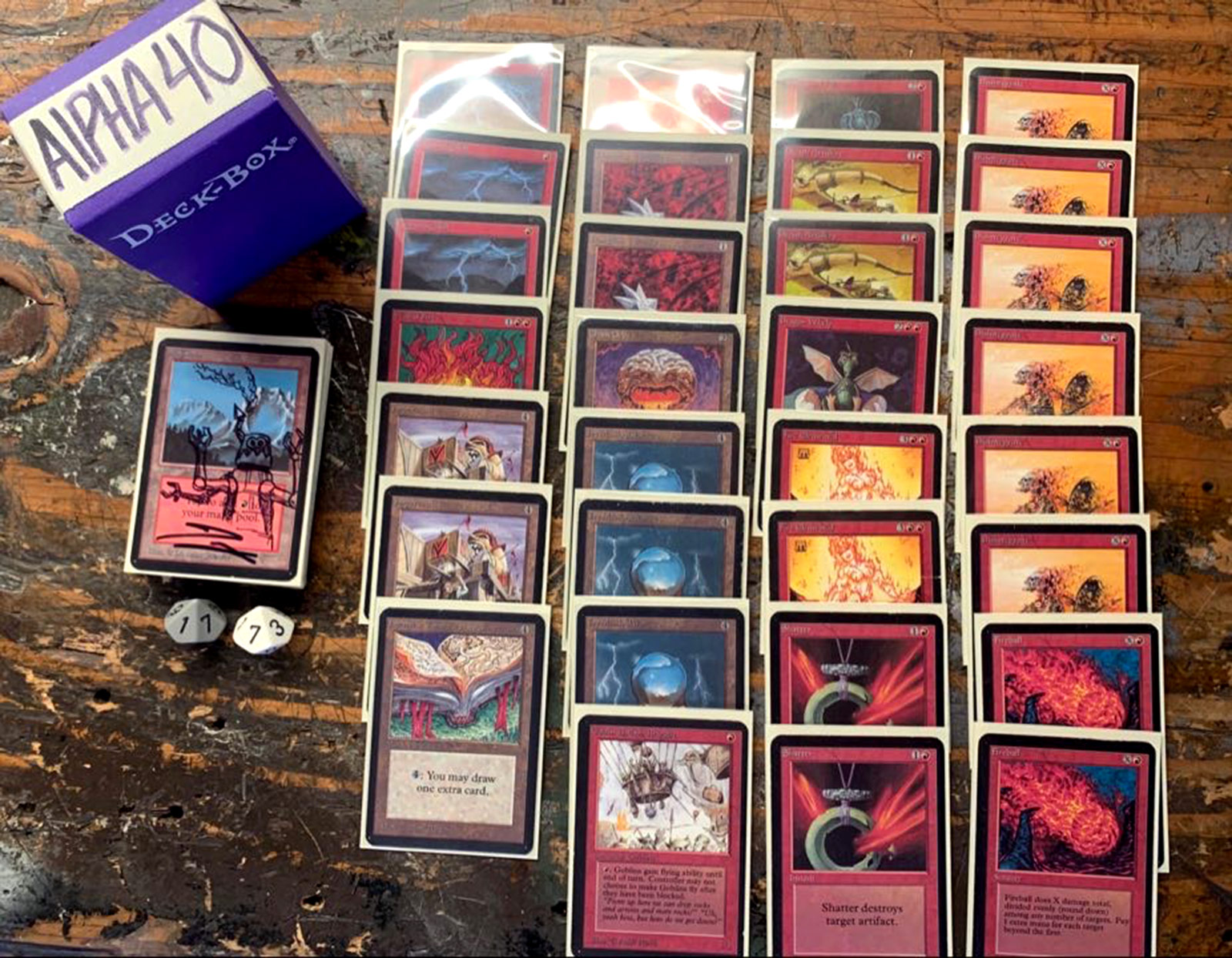
Match 3 vs. Ian Braun playing Goblins
Ian “Braunsky” was my pre-league test match described in my June report, so I was excited to see what he was playing this time, and I was not disappointed.
Game 1: He called odd, but we rolled a 6, so I was on the play. This was my opening hand:
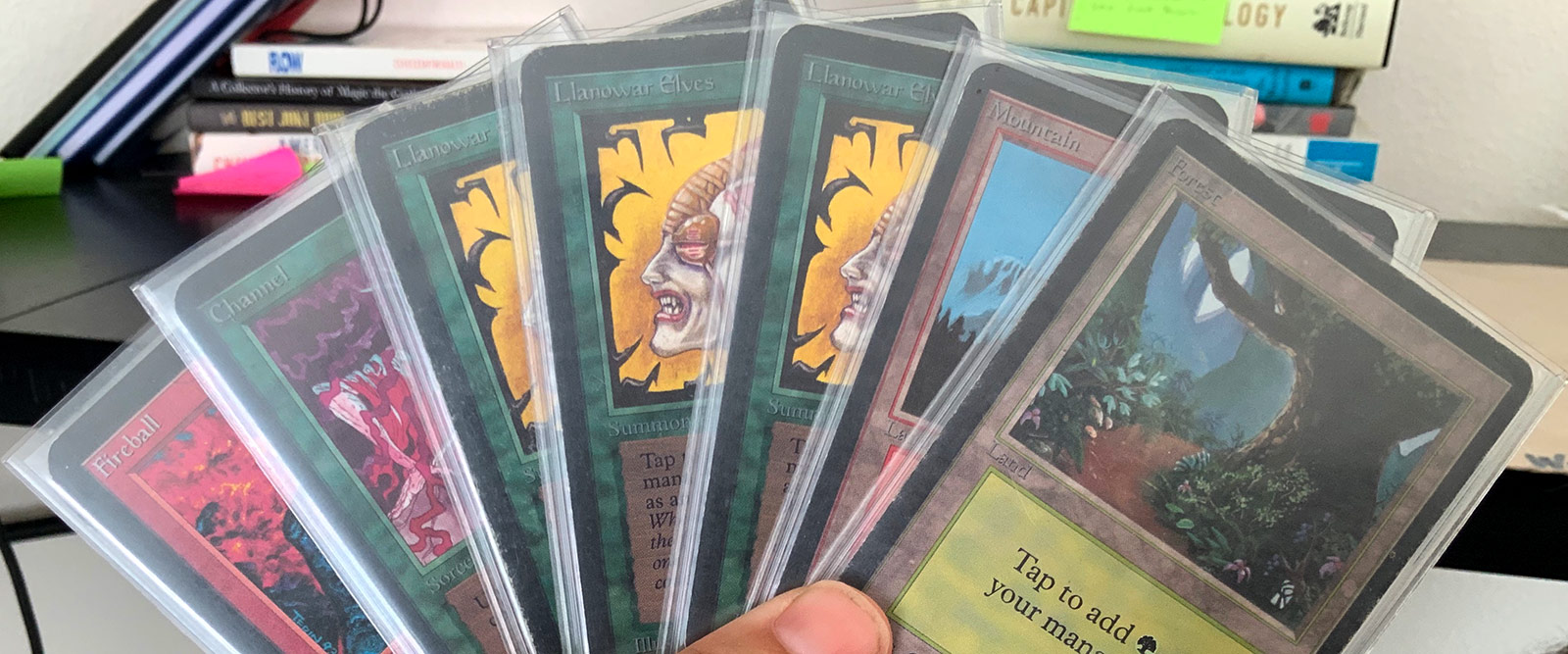
Hilarious. It pretty much plays itself. I opened with Forest into Llanowar Elf. He opened with Mountain into Lighting Bolt on my Elf.
I drew Lightning Bolt, and then played the second Elf. He played a second Mountain, and cast double Goblin Balloon Brigade. The way was now clear. On his end step, I Lightning Bolted him, sending him to 17.
I untapped for my third turn, cast Channel and then Fireball for 17. Ian asked me to halt so that he could screen shot the game state for his brother, which I happily obliged, and took this shot myself.
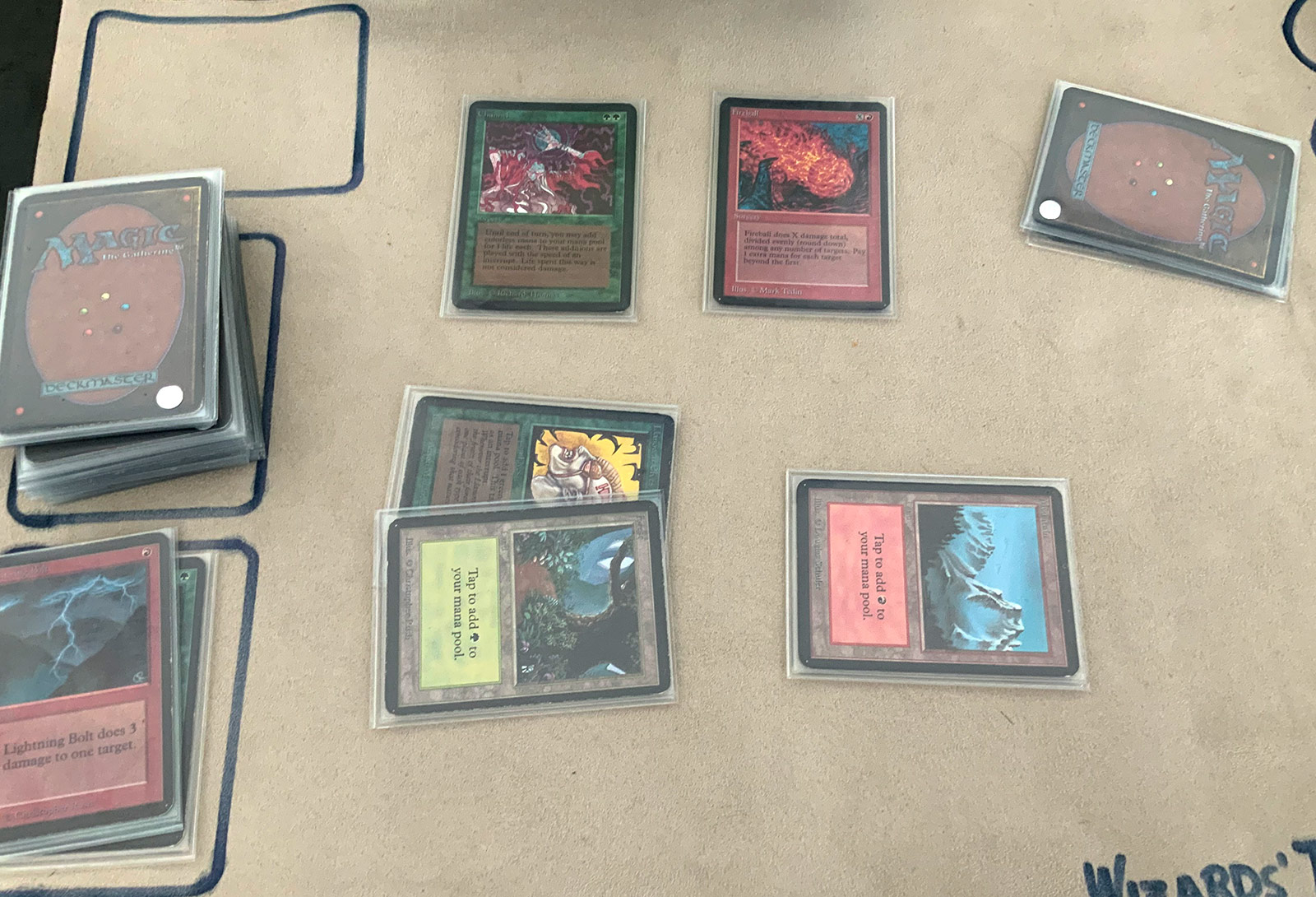
Game 2: This game was fascinating. He landed several early Gobbos and Orcish Oriflamme. I used two early Fireballs to wipe multiple Gobbos, getting a 2-for-1 in each case. My Juggernaut got burned out with a Fireball, but my Jade Statue stuck around and swung in a few times, sending him to 10, before he played his own Juggernaut. I drew Lightning Bolt, but hesitated, thinking I’d be better off trading the Jade Statue (the Juggernaut was powered by the Oriflamme). I could have attacked him to 8, and Bolted the Juggernaut, but instead, I just passed the turn, doing nothing! Whoops!
I Bolted the Jugg when he attacked, and then missed my window to get him low, because he followed up with a Dragon Whelp and a Goblin King.
I drew Fireball, and counted up my mana. If I had sent him to 8, I could kill him on the spot, because I had 7 lands and an Elf in play. Instead, I was now on defense. I tapped down to kill the Whelp and the King, wiping his board, but leaving me with just an Elf, and now in top deck mode. He rebounded, and eventually killed me with an unblockable Goblin King powered up with the Oriflamme, sending me from 8 to 4 to zero. Goblin King is a house in Alpha Constructed!
My minor miscue led to a frustrating defeat, but I felt I was well-positioned to win the match. And even if I didn’t, it was a valuable lesson learned.
Game 3: My opening hand wasn’t too exciting. I had an Elf, plenty of land, and four mana spells. I opened with an Elf, and he opened with a Balloon Brigade. I drew a second Elf, so I decided to attack with the first. He somewhat surprisingly (to my mind) traded with me. Since his Goblins become so threatening when backed with Goblin Kings, I didn’t expect a block and trade. I played the second Elf and passed.
On his second turn, he played double Balloon Brigades. On my third turn, I cast Juggernaut. He Shattered it and attacked me to 18. Not looking good for me.
Under Alpha League rules, a single Balloon Brigade activation gives all Goblins flying until end of turn. Alpha League play strives for greater textualism than is typical of sanctioned or most forms of Old School Magic – which means that the league authorities hew more closely to printed text, more often than not, producing fun and unusual card interpretations. If he lands a King, I’ll be dead in short order.
On my fourth turn, I believe I played another Juggernaut. On cue, he cast Goblin King on his fourth turn, and then paid a single red mana to give both (that’s Alpha rules for you) of his Balloon Brigades flying (I hadn’t yet played a Mountain), sending me to 14.
On my fifth turn, I drew and played a Mountain (with a Bolt and 2 Fireballs in hand), and Bolted the King, and then attacked with Juggernaut, sending him to 15. Then things slowed down a bit. He picked off my Juggernaut with either a Fireball or a Bolt, and then attacked me to 12 with the remaining Goblins.
I used one of my two Fireballs to take down the Brigades and attacked him with an Elf (sending him to 14). He played a Juggernaut, which I answered with an Icy Manipulator. I cast a Jade Statue with two mana up, which I used to kill his Juggernaut (by virtue of blocking his 5/3 Juggernaut with my 3/6, because of Juggernaut’s clause forcing it to attack each turn). He played a Dragon Whelp, which was now the target of my Icy. I attacked him with the Jade Statue, sending him to 11, and then tapped the Whelp during his combat phase.
That’s when I drew Channel. I verified life totals: him at 11 and me at 12. I then cast Channel, and paid 8 life (keeping just out of Lightning Bolt range), and then tapped four more mana to cast a 12 point Fireball, directly at him. That was game.

What an intense match!
Here’s what Ian played:
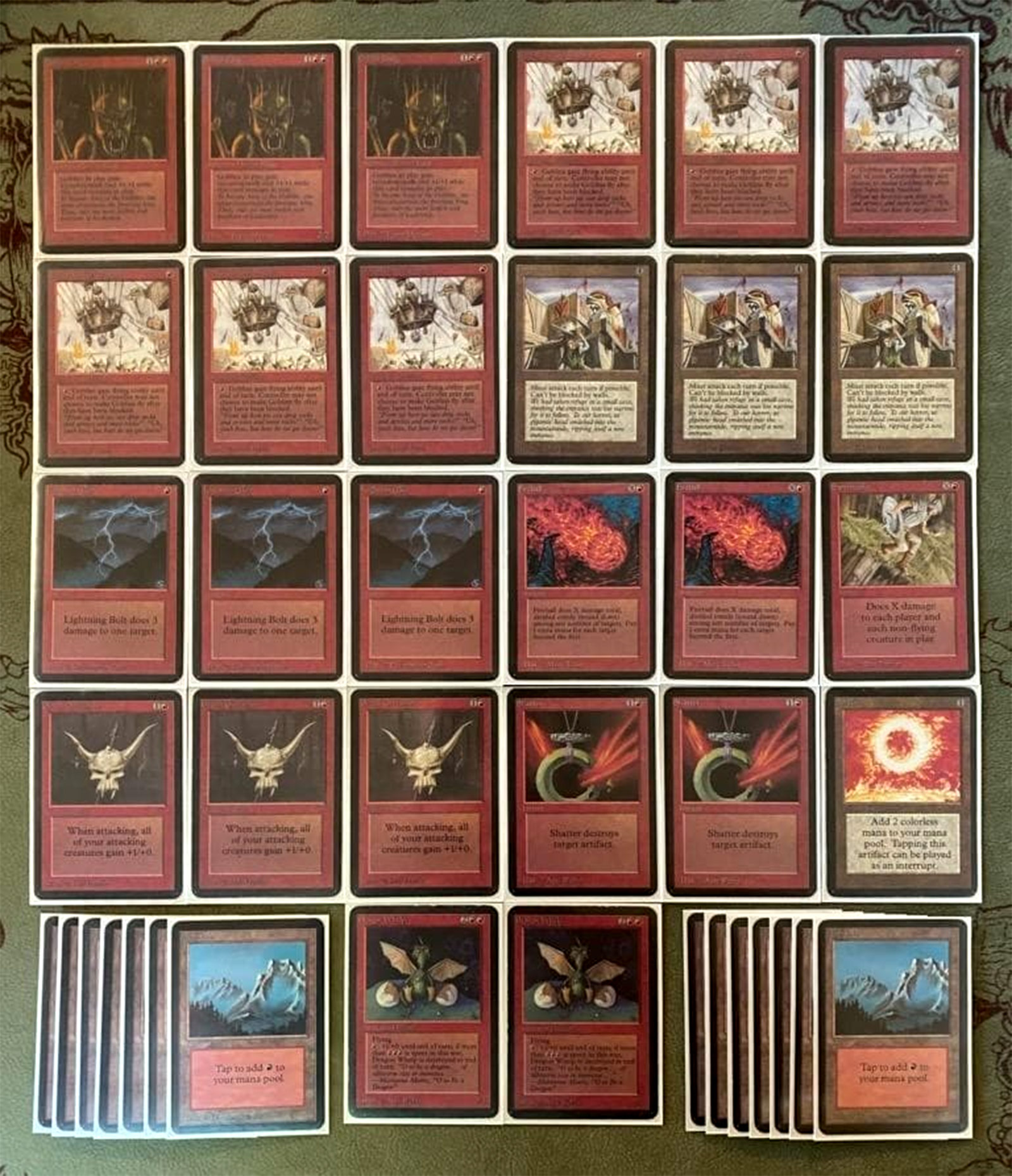
Match 4 vs. Paul Palagou playing Mono Black
Paul was one of the players who ran the 9 Sinkhole deck in the months before the League authorities moderated it to 3.
Game 1: Paul won the die roll and opened with a Swamp, and I knew this was going to be a fun match. I played Forest into Llanowar Elf. He played a turn 2 Swamp and passed. I played a land and then cast Disrupting Scepter, and passed the turn.
On turn three, he played another land and cast Dark Ritual into Sengir Vampire. I contemplated my options. I believe he had just two cards in hand. I could Fireball the Vampire, but I’d lose a crucial opportunity to deny him another card with my Scepter. I also had an Icy and a Juggernaut in hand. I decided to use the Scepter on him, and he discarded a Plague Rat.
On his fourth turn, he attacked me for 4, sending me to 16, and cast another Plague Rat. If his deck was full of Rats, I’d need to eventually deal with that. On my fourth turn, I Fireballed the Vampire. For his fifth turn, he played another Rat and then a Disrupting Scepter of his own. He was now out of cards. He held back the Rat because of my Elf.
I untapped, and cast Juggernaut. He untapped and cast Drain Life on it, going to 22 (I somehow snuck an Elf attack in there).
I played an Icy, and then another one, and used one to keep his Rat tapped down, and started attacking with a pair of Elves, ticking his life from 20 to 18 to 16.
I played a third Elf, and then he played a Hypnotic Specter. I attacked with all three Elves just to get his life down to 13, closer to Fireball range, and he blocked and killed one of them.
I Icy’d his Hypnotic, even though I drew a Bolt, because I figured I could now win. I Bolted him on his end step (after tapping his creatures down with Icy’s), and then cast a lethal Fireball on my main phase, using Channel as a quasi-Ritual for the final damage.
Game 2: This game was fairly straightforward. I opened with a Sol Ring and a second turn Jade Statue, and started attacking, and there was really nothing he could do about the Statue.
I picked off his Rats with Fireballs and kept attacking until he was in Fireball range. I Bolted him from 9 to 6, and then untapped and Fireballed him for 8 for the final touch.
At 4-0, I am the only undefeated in my pod, and am advanced along to the quarterfinals.
Quarterfinals vs. David Antuzzi playing Black/Green Fungusaur Combo
Game 1: I lose the die roll, and am terrified when he opens with Swamp, Dark Ritual, Sol Ring. But the degree of fear was matched by an equal measure of relief when he used that mana to play two Drudge Skeletons. Curiously innocuous, I thought. This must be worse for me than it seemed.
My opening hand also had Sol Ring, but just a single land. I played my Forest and Sol Ring and passed the turn.
On his second turn, he cast Pestilence! That is awful for my deck, which has six Llanowar Elves. He attacked me with the Skeletons and passed the turn.
I failed to draw a second land, and had to sit in frustration. I played a Llanowar Elf to bait him into using Pestilence to kill his Skeletons. He didn’t take the bait.
On his third turn, he played a Forest, and cast Fungusaur. Now things would get interesting. He put a Paralyze on my Elf, attacked me with the Drudge Skeletons, and passed the turn.
I finally drew a second Forest, and surveyed a hand with 3 Juggernauts, at least one Jade Statue, and one Icy Manipulator. I decided to play a Juggernaut, with a plan to play more, since they were useful on defense (at least at first), and offensive.
It was all for naught.
He played a Dark Ritual and activated Pestilence 4 times, but only one use at a time, allowing the Fungusaur to grow with each activation. His Skeletons and my Juggernaut and Paralyzed Elf were wiped off the board, and the Pestilence damage sent me to 8. From here, he easily killed me with a massive 8/8 Fungusaur (but could have done much more).
Game 2: David developed more slowly this game, landing a Drudge Skeleton and a Pestilence. If you activate a bunch of Pestilence abilities at once, you can bunch them up, allowing them to resolve simultaneously, and thus only kill the Skeleton once, allowing it to regenerate. This is a neat trick. But I used an Icy Manipulator to tap down his lone untapped Swamp after he played a Hypnotic Specter, and then Fireballed both his Hypnotic Specter and Drudge Skeleton, a three for one when Pestilence went down as well at the end of my turn!
I then drew a Disrupting Scepter, and decided to hold off on playing any creatures other than the Jade Statue until I could empty his hand of Pestilence. It took a while, because he drew a bunch of them, but I eventually did so, holding onto a full hand of 7 cards when I finally emptied his hand out.
Once that was done, I deployed more of my threats, and began to attack him. He topdecked a Drain Life to get me under 10 life, and after that he drew and cast Nightmare. I had to use my Icy to keep it tapped, but eventually the Jade Statue and a pair of Elves, later joined by a Juggernaut, killed him.
Game 3: This game began with another harrowing moment, because I was forced to keep another 1 land hand. Fortunately, it yielded another two lands in the first few turns, as well as a Sol Ring. A second turn Lightning Bolt (the first time I drew one this match) nailed his Hypnotic. I decided to play the control role, and opted to cast two Icy’s before a single Juggernaut or Jade Statue. This proved to be wise, because it allowed me to keep a Throne of Bone offline, and eventually hold off a Nightmare. A Hurricane took it from the sky, and then a pair of Fireballs did the rest.
Game and match!
Here’s what David played:
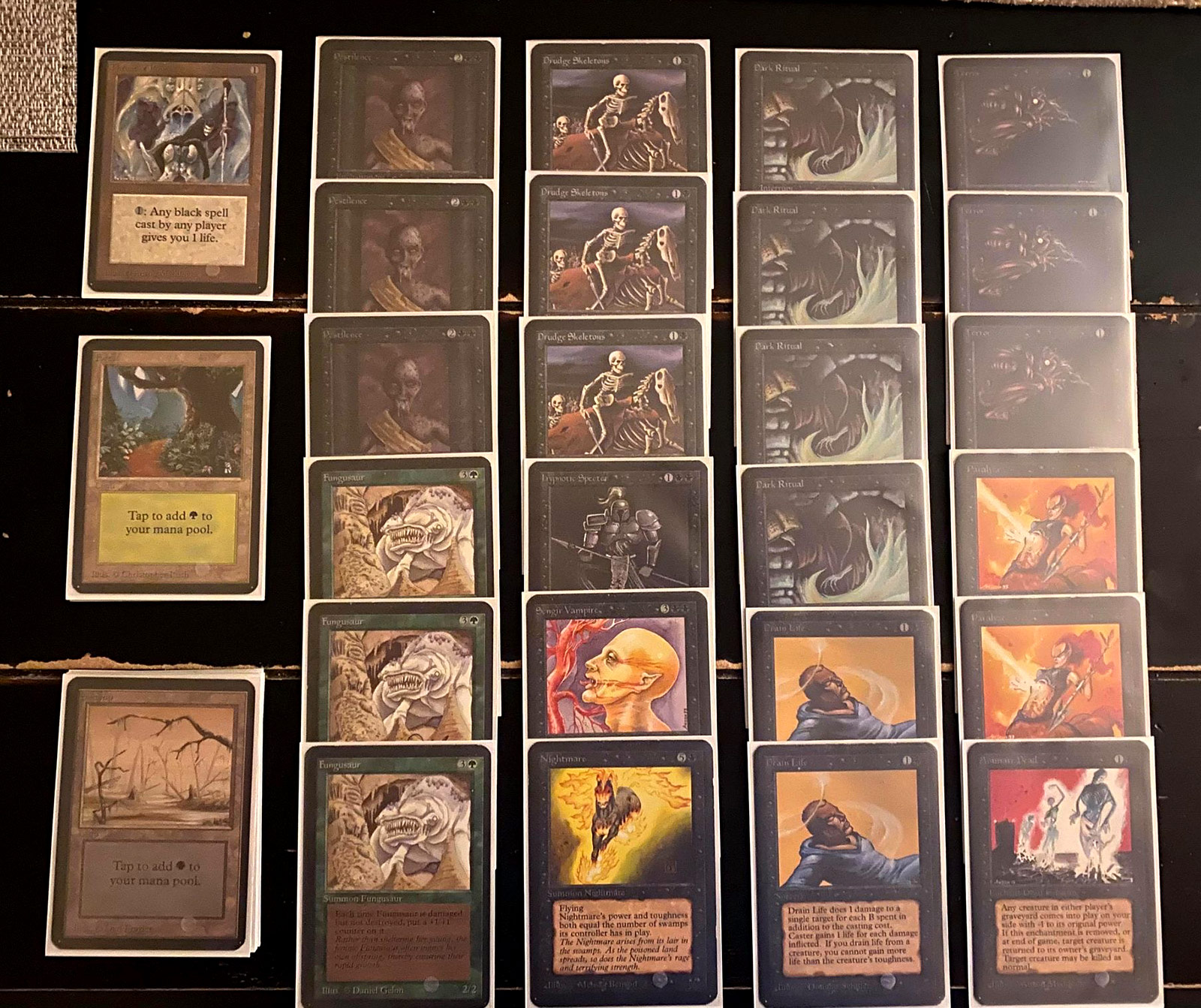
Semifinals vs. Shane Mccandlish playing Black/Red
Game 1: Shane won the die roll, and elected to play. He opened with Swamp, go. Intriguing, I thought.
I played a Mountain and passed the turn. On his second turn, he cast a Drudge Skeletons. Not this again, I thought. I played out a few Llanowar Elves to develop my mana, and cast an Icy Manipulator at the first available opportunity.
I got him in a 2-for-1 with Lightning Bolt when he tried to Unholy Strength, I think, a Hypnotic Specter. He played another Specter, but I kept it pinned down with an Icy. Then I landed another Icy, and used that Icy to tap down his Drudge Skeleton. He Terrored one of my Elves, and then Fireballed a Juggernaut, and Shattered another.
I played a Jade Statue, which stuck, and I got one clear attack with an Elf and the Statue, sending him to 13. He tried to gum of the works more, but he tapped down, so I was able to Fireball a Troll that was Unholy Strengthened, and get it off the table, leaving him with just the Hippie and Skeleton, which I had pinned down with Icy’s.
I attacked him with a Jade Statue from 13 to 10. On his following end step, I Bolted him directly, sending him to 7, and then untapped and launched a Fireball for 8 directly at him, winning the game!
The play sequence of Bolt and then Fireball for the win was a recurring pattern in this League.
Game 2: My hand was so good, but lacked a Mountain. Roughly, it was Forest, Forest, Llanowar Elves, Channel, Fireball, Jade Statue, Sol Ring, and the Hurricane I drew on my first turn.
He played a Swamp and passed the turn. I played Forest into Llanowar Elf on my first turn.
On his second turn, he played Mountain and cast Drudge Skeleton. On my second turn, I attacked him with an Elf, knowing he wouldn’t block. I then played a second Elf (which I drew) and a Sol Ring, and passed.
On his third turn, he attacked, and I blocked this time. He played a Troll, and then passed, leaving up just a Swamp.
I drew Mountain. Huzzah! I played the Mountain. I tapped my two Forests and cast Channel. Then I tapped the Elf and the Sol Ring and Mountain, and cast a more-than-lethal Fireball. That’s it!
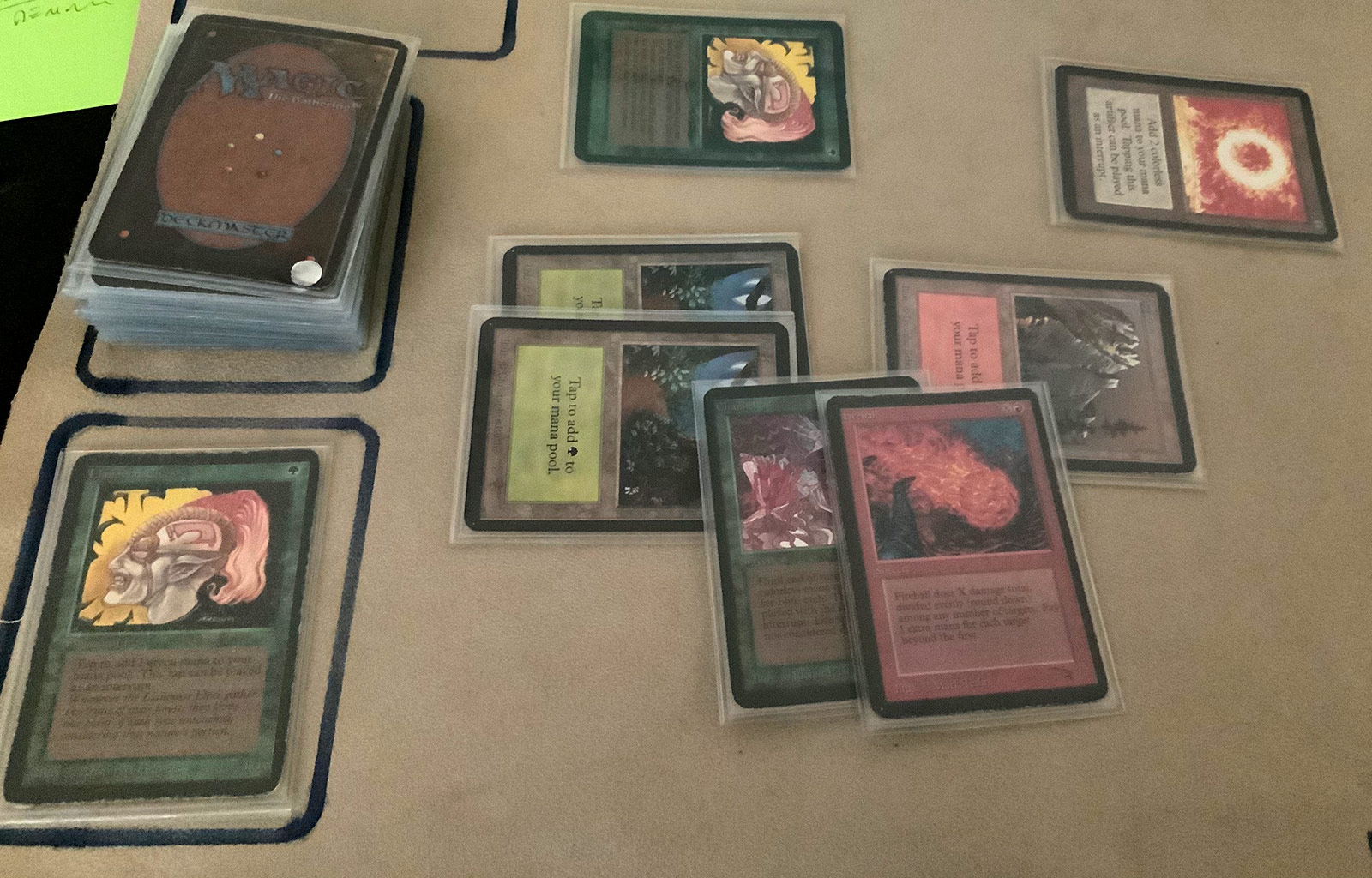
Here’s what Shane played:
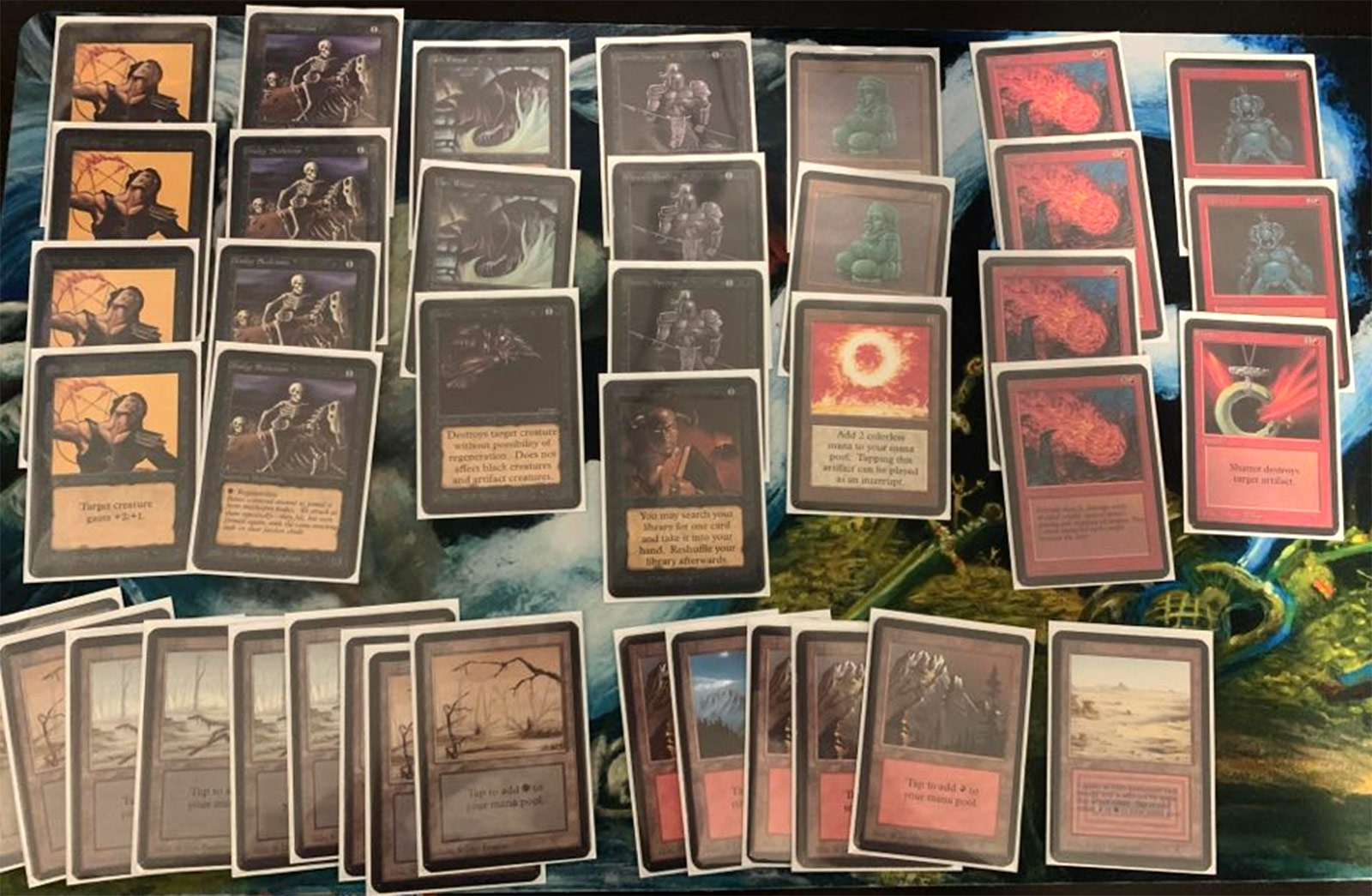
Finals vs. Joel Mick playing Elves
Joel is one of the original Alpha playtesters, and we played Alpha v. Pre-Alpha (one of his decks of playtest cards!) at Eternal Weekend last year. He also won the June League as shown in this video.
Joel engaged in a bit of playful banter and trash talk leading up to our match, claiming that he was going to cast a first turn Channel-Fireball twice on me as revenge for my deck choice in the Wizards Tournament 2.
The League organizers wanted to live-stream our finals match, which I happily obliged, and so the entire epic event is recorded for posterity and your enjoyment. Before I describe the match, check out the video here:
It’s worth watching the video first, because I am going to describe the sequence as my thinking.
Game 1: Joel won the die roll, and elected to go first. He opened with Forest into Llanowar Elves. I did the same! I think Joel was more surprised than I was to see that Llanowar Elves had carried two players to the finals!
On his second turn, he played another Forest, attacked for 1, and played two more Elves. On my second turn, I did the exact same thing. I played another Forest, attacked him for 1, and then played two more Elves, prompting Joel to ask if we were playing the same deck!?!
Obviously, neither one of us knew the answer by this point. The League organizers had kept the decklists under wraps.
On his third turn, he attacked with just a single Elf, and I blocked with a single one of mine, trading Elves. He played another Elf (a fourth) and passed. At this point, I figured he was playing more Elves than I was.
My decision to trade Elves proved to be an error, as I drew Fireball on turn three. If I had all three Elves, I could play Mountain, and cast Fireball for 1 on three Elves, leaving him just one left (but me with 3). But I had no way of knowing that I’d draw Fireball. Still, in retrospect, that seemed like a bad trade for me. Instead, all I could do was cast a Fireball for 1 on two targets, leaving him with an Elf still. I attacked him for 1 and passed back.
He played a Forest and attacked me for 1, making the life total 18 even.
On my fourth turn, I decided to cast and activate Disrupting Scepter. He was holding four cards, and I felt like I should leverage my somewhat better board position into card advantage. His four cards represented an unknown, but likely danger. He discarded a Hurricane, which revealed almost nothing.
He attacked me with a single Elf, and then played another, leaving three cards in hand. On my fifth turn, I activated the Scepter again, and he discarded another Elf. To get that many Elves this early, I realized he was probably playing double-digits.
On his sixth turn, he drew a card and now had exactly three cards in hand. He attacked with both Elves, and I announced that I’d block one. He responded by casting Giant Growth on the Elf I blocked, and then Berserk, and another Berserk. Bear in mind we were both at 17 life. I took 15 trample damage, and the one from the unblocked Elf.
I drew nothing on my next turn, and he drew a single card and attacked. It was a Giant Growth, which killed my blocking Elf. I drew a Juggernaut, which is compelled to attack, and nothing useful after that. He gladly took a Juggernaut attack, and then killed me on the swing back.
Game 2: This game had a similar opening: both of us played Forest into Llanowar Elves. The pattern broke, however, when I cast Sol Ring and Juggernaut on Turn 2.
On his second turn, Joel played another Elf, but then cast a Winter Orb. However, Winter Orb loses much of its luster against a Sol Ring.
On my third turn, I attacked with Juggernaut and cast Fireball for 1 on two targets (leaving a land untapped), killing both Elves. He did nothing on his third turn.
On my fourth turn, I attacked with Juggernaut and Elf, and he Berserked the Juggernaut, knocking him down to 4, but killing my Juggernaut. Berserk can be a painful removal spell!
I drew a Lightning Bolt, so I used the Bolt and my Elf to kill him the following turn, setting up a decisive third game!
Game 3: Predictably, Joel opened with Forest into LlanowarElf, and I matched it.
But on turn two, he played three Elves, giving him four in total. On my second turn, I played a second Elf and a Mountain.
On his third turn, he played another Forest, and attacked me for four. I learned my lesson. No blocks! He played a fifth Elf, and passed the turn with just two cards in hand.
I had a Fireball in hand, but I also had a bunch of four mana artifacts. I couldn’t Fireball more than two Elves, so I thought the best play on my third turn was just to cast Juggernaut and hope it trades 2-for-1.
Indeed, on his fourth turn, he draws a card (now three cards in hand), and attacks with all five Elves. I block just with the Juggernaut, and he cast Giant Growth on the one I blocked. I take 4 damage, and am now at 12 life. He played another Elf, going down to 1 card, and passed the turn. He now had 5 Elves again.
My intended plan for my fourth turn was just to cast Fireball for 1 on three targets, killing all but two Elves. I drew Channel, however, and my options greatly expanded, despite my life total. After drawing Channel I utter “wow” under my breath. This prompts me to reconsider everything.
I’ve never cast Fireball on 5 targets before. I grabbed a sticky note to try to calculate how much mana is required to cast a Fireball for 1 on five targets, and realized that it was 10, but then screwed up the execution.
I tapped two Forests and cast Channel. I then announced that I’d pay 8 life to add 8 mana to my mana pool. I tapped my Mountain to get things started, and then one Elf and a Forest to cast Fireball – except that I was paying 11 mana here. The first target only costs 1 mana (plus the initial red), but every additional is two mana. But I somehow overpaid, and put 11 total mana into the Fireball. It doesn’t change the Fireball (since it’s all rounded down), but it was one more life than I needed to pay and still have an Elf untapped.
What I wanted to avoid was twofold: 1) he had 3 Forests, and I wanted to avoid dying to a Hurricane now or in the next few turns, and 2) having him Giant Growth an Elf to survive one of the Fireballs, and then killing me next turn with a Giant Growthed Elf (he’d have to draw another Giant Growth next turn, because in this scenario, he needs a Giant Growth now, with just one card in hand).
All five Elves died, the outcome I desired!
On his fifth turn, he played another Elf, with just one card in hand (just three Forests). He was now one mana away from killing me with a Hurricane, unless I did something fast.
On my fifth turn, I could cast a Jade Statue (I had two in hand) or an Icy Manipulator. This was the critical decision of the match, and I knew it.
If I played Jade Statue, I could block and then attack, and that was my fastest clock, but it was quite mana intensive.
Ultimately, I concluded that I had to play Icy. Only Icy allowed me to tap his Elf down, and keep him off of a lethal Hurricane next turn if he drew a Forest. Indeed he drew a Forest, but I fortunately tapped down his Elf in his upkeep. He now had one cards in hand.
My immediate objective at this point was to get his life low enough that he couldn’t win with Hurricane, but would force a draw, and another game.
I decided I needed to apply pressure. I attacked with one Elf and then played Jade Statue, and used the other Elf to activate Icy to tap his Elf again in his upkeep. He drew, and passed the turn.
I drew a Fireball, and had many options. He had two card in hand. I could animate Jade and attack for 5, sending him to 13. But I really wanted to get rid of his Elf, and then Icy one of his Forests. If he had a Giant Growth, that would set me back a full turn in terms of attacks, because I’d need to Fireball for 4. I decided to chance it, and Fireball the Elf, but Joel had the Giant Growth to keep it around.
No matter, I attacked him for five, sending him to 13, and tapped his Elf again in his upkeep.
On his seventh turn, he drew, and passed the turn again. At this point, I contemplated playing the second Jade Statue, but realized that the result would be the same, in terms of getting him to 4 life or less. I attacked him for 5 this turn, sending him to 8, passed the turn, and pinned his Elf again with my Icy on his upkeep.
On his eighth turn, he drew and passed – with three cards in hand. That was the critical draw, however, because now I had him under 4. I animated the Statue and attacked him to 3. Now I was safe. I cast a pointless Disrupting Scepter, passed the turn, and tapped his Elf again.
On his ninth turn, he drew a Forest, but with defeat inevitable, he revealed that he had been holding a Hurricane all these turns, and furthermore that he drew a second Hurricane the turn before (Turn 8). Had he anticipated this, he could have cast a sub-lethal Hurricane many turns before, and killed me (or draw the game) on his eighth turn! Of course, if he had drawn more Forests, he would have been able to kill me either way.
The critical error, on my part, which made this game so close was overpaying by a single mana (and life) for a Fireball with Channel. If Joel had sequenced both Hurricanes, depending on the turn he drew them, it’s possible he could have killed me or caused a draw. But the dramatic twist was my error may have nudged him to hold off, because he was so close to killing me with it.
All in all, this was a fantastic and unforgettable match of Magic against a person who was there from very beginning.
Here was Joel’s deck:
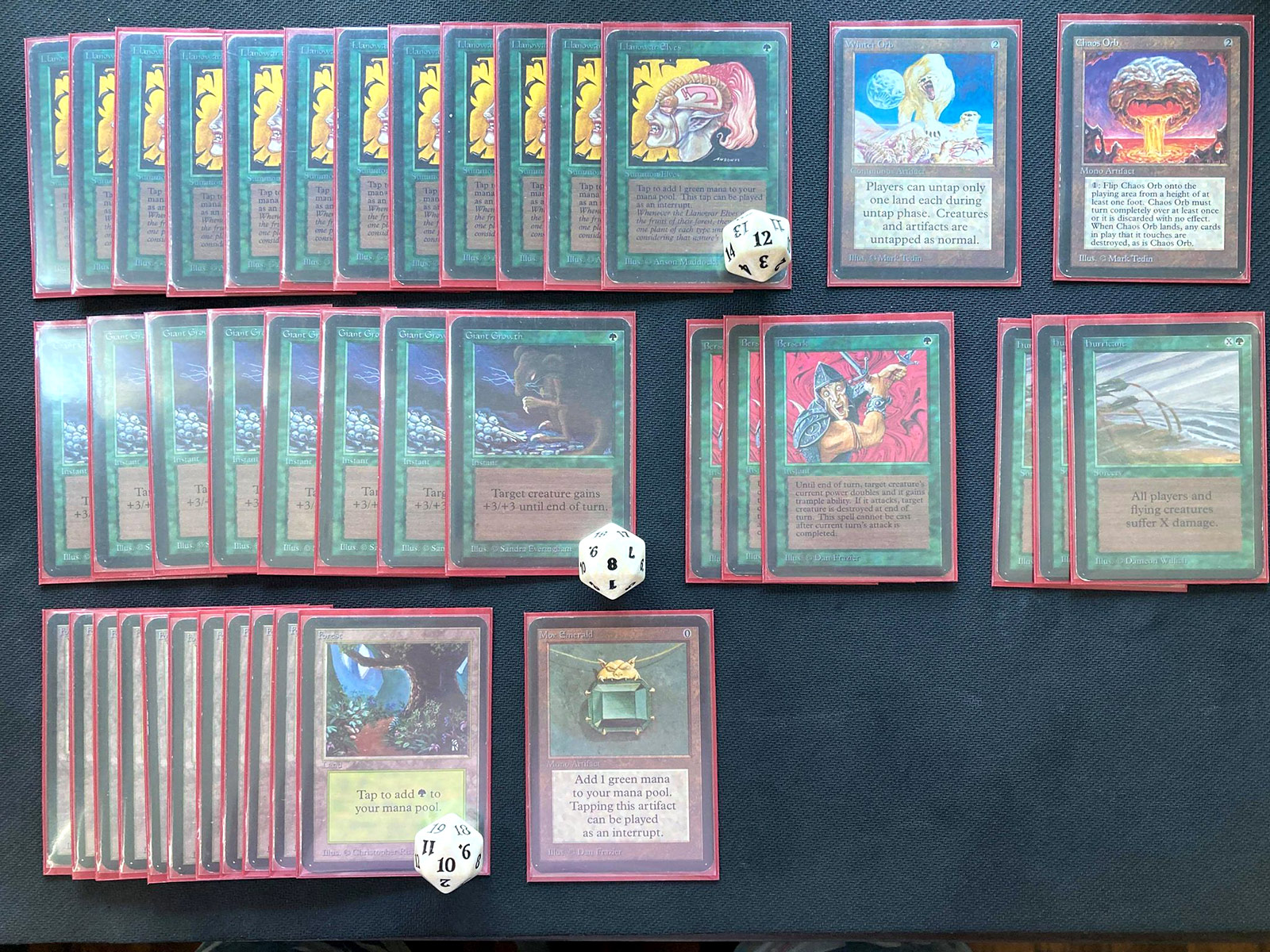
And, he even put together a nifty deck tech video, which you can watch here.
Conclusion
If you enjoyed this article even a small fraction as much as I enjoyed my July Alpha League experience, then you had a darn good time.
Despite a severely constricted card pool (both in terms of the number of cards in Limited Edition Alpha and the difficulty in acquiring those cards), competing in Alpha League has revealed new facets of Magic that I may never have otherwise experienced. One of the trade-offs for playing with a format that is a mere 295 cards (fewer, if you count each basic land once), is that league authorities permit players, in a constructed context, to play unlimited quantities of many cards.
Since the default in constructed Magic has been, since 1994, either 4-of or 1-of maximums (restricted cards or singleton/highlander formats like EDH) per card, there has never been a well-developed context in which to explore the strategic possibilities of unbounded card caps. Alpha 40, and to a greater extent, Alpha League, bring those possibilities into focus. Because Alpha League authorities have imposed strict limits on most of the most “broken” possibilities, they have, paradoxically, opened up more, or at least, less explored, alternatives.
This unique combinations of constraints (and unlocked constraints) make decks like the Benalish Hero deck, the Plague Rat deck, or Joel Mick’s “Elves” deck a fascinating deck building exercise. Not only is this fascinating in terms of the novelty that such deck construction rules create, but also in terms of the intellectual exercise of figuring out how to optimize such strategies without the usual constraints. For example, in what ratios do you play Plague Rats with accelerants like Dark Ritual, removal spells like Terror, Paralyze, or Pestilence? Similarly, is the Benalish Hero deck optimized by including a few copies of Blessing, Swords to Plowshares, and Disenchant? Perhaps Armageddon or Meekstone? Joel’s deck answered questions we probably never thought to ask about building around Llanowar Elves, and raised many more.
In coming years and decades, these are corners of the overall Magic experience I look forward to exploring further. As the Old School Magic experience widens and broadens beyond mainstay formats like “93/94,” I am discovering new ways to enjoy my favorite cards, get a dose of the aesthetic experience I have long savored, and acquire further strategic insights. Alpha League and Alpha 40 may be beyond the reach of most players, but I hope that enterprising organizers conceive of similar formats down the road. Perhaps instead of restricting all players to just Limited Edition Alpha, someone might broaden a competitive experience to include Limited Edition Beta and Unlimited. Hell, I’m still waiting to play just “Old School 93,” which includes Alpha, Beta, Unlimited, and Arabian Nights. Or equally intriguingly, I’m down for Arabian Nights Constructed (and for figuring out a good banned, restricted, and moderated list for it). The point is that there is far more fun to be had in just the Old School corners of Magic than either the 93/94 format suggests or than we may appreciate. I feel like the door is just opening on these tantalizing possibilities.
Thank you for accompanying me on this recounting of one of my adventures with Alpha. I’ve already brewed some exciting new decks for Alpha League that I might share with you in coming months. Your feedback may encourage me to do just that.
Until next time,
Stephen

